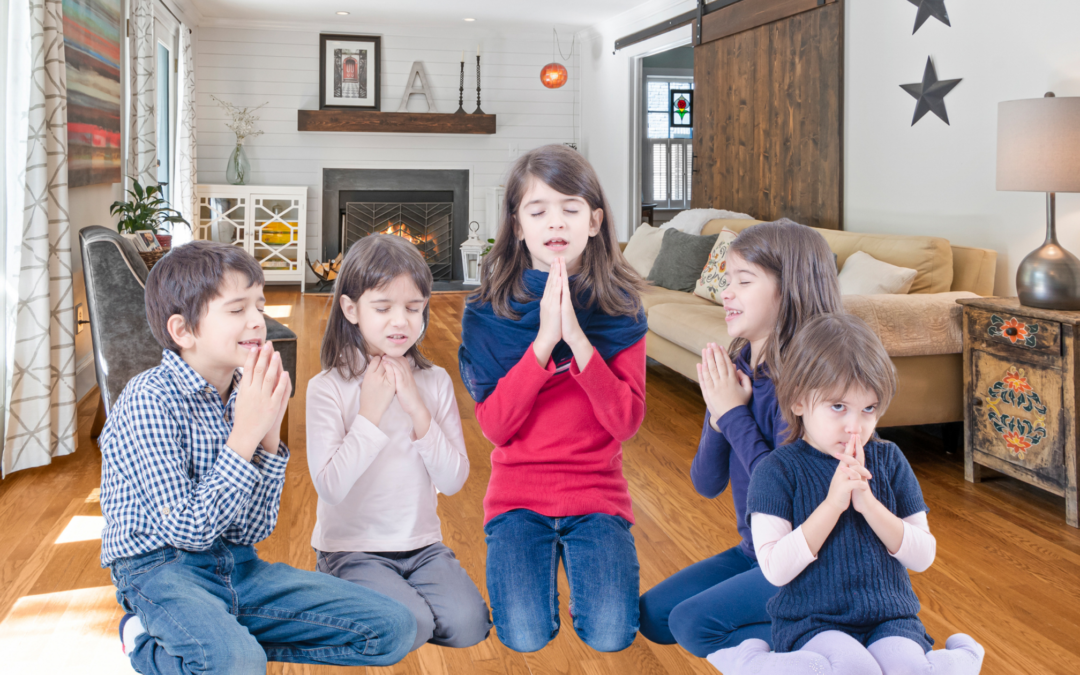Family Prayer: Building a Domestic Church in Your Homeschool
One of the most insightful passages of the Second Vatican Council is the statement of the dogmatic constitution Lumen Gentium describing the family as “the domestic church” (Lumen Gentium, 11). It is through the family that children are first introduced to the faith and see it practiced in the daily routines of domestic life. Parents are a child’s first role models in religion. Through their character and example, children imbibe what it means to be Christian. Family prayer is an integral part of the domestic church, which countless saints and popes have recommended as a salutary manner of growing in faith and strengthening family bonds.
While we all recognize the value of family prayer, it is sometimes difficult to practice it. If your kids have been going to a brick-and-mortar school, they’re gone most of the day and then busy with homework in the evenings, leaving scant time to develop lasting routines of family prayer. Even homeschooled families often find their kids’ schedules so packed with extracurricular activities that the family is seldom in one place simultaneously. Or maybe you or your spouse are so introverted and awkward that the idea of leading your children in prayer is intimidating. What can be done?
In this article, we will review some strategies for building a routine of regular family prayer so that your household can truly blossom into the “domestic church” spoken of by Lumen Gentium.
Prayer is a Habit
Sometimes, we imagine that prayer should just come easy for us—that it should spring up of its own accord from a heart overflowing with praise and gratitude. While that may be the case occasionally, that is not most people’s experience. For the vast majority of us, prayer is a habit that must be patiently cultivated through deliberate, disciplined adherence to a routine. This means applying yourself to carve out times for prayer throughout the day, learning how to pray, and persevering in this resolution for the long term. Just as physical fitness requires adherence to exercise and diet regimens over the long haul, cultivating prayer in your household requires perseverance. It needs to become habitual, a regular act structured into your life through repetition.
But how can we do that, especially if our schedule is already cluttered?
Finding Time for Prayer
If your day is already busy, the best way to find time for prayer is to tack it on to the beginning and end of things you and your children are already doing. This way, you won’t upend your entire routine. Here are some examples:
Prayer Before School: Lead your children in a short prayer before beginnign the school day. Help your children to clear their mind and prepare for their studies with grace and balance. This is something children can lead on their own, with older siblings guiding the younger.
Acts of Thanksgiving: Make acts of thanksgiving after completing a class, test, or project. Get in the habit of offering a short prayer of thanks when concluding something as a way of “buttoning it up.”
Meal Prayers: A short blessing before or after meals is a common routine in most Catholic households. If it’s not, introduce a formal act of thanksgiving and blessing before sit-down meals. Additionally, you can encourage kids to make their own prayers of blessing on their own before snack time.
Car Prayers: If you’re on the go a lot, car rides are a good time to get some prayers in. Many families have a “Rosary drive,” where a half-hour commute provides time to get in a family Rosary.
Visits to the Blessed Sacrament: When you are out and about with your kids, make impromptu stops to visit the Blessed Sacrament. It need not be for long. Just popping in for five or ten minutes is sufficient. This is enough time to let you and your kids get some quiet time with the Lord.
The Angelus: The Angelus is a traditional prayer said at midday. It is short and sweet and can be tacked on to prayers before lunch. Here’s a link if you’re not familiar with the prayer.
Prayers Before Bed: Countless spiritual writers recommend prayers before bed as a way to give thanks for the day and ask God’s protection through the night.
Devotions Before or After Mass: If you are able, show up a few minutes early to Mass to do prayers for the family before a side altar or statue in the sanctuary. Alternately, if you’re one of those “rollin’ in at the Gospel” families, stay a few minutes after and incorporate these prayers into your thanksgiving prayers after Mass ends.
If you’ve not yet formed a habit of family prayer in your household, I don’t recommend trying to implement all this at once, as it will likely be too much. Rather, choose one or two to introduce first—before school and before meals or bed time are good places to start. Work on establishing a habit with these beginning prayers, and then gradually extend from there. Go slowly and with great care. Remember, this is not about forcing your children recite memoried prayers by rote; it’s about cultivating a habit of turning to God throughout the day in petition, praise, and thanksgiving. It is better to pray well than to pray more, so focus on the sincerity and quality of the prayers you introduce rather than worrying about how much you are introducing. You can always expand later.
Making Prayer Meaningful
The Catholic tradition is full of wonderfully concise prayers that can be memorized for all occasions. While kids should definitely learn these prayers and use them throughout the day at family prayer times, we must be careful not to communicate that prayer is nothing more than memorizing formulas. The Catechism of the Catholic Church says that prayer is “raising one’s mind and heart to God” (CCC 2590). However we choose to incorporate prayer into our homeschool, we should do so in a way that teaches children to raise their minds and hearts to God. This should be built on three pillars:
1. Memorized Prayers: Teach your children the traditional prayers to be learned be recitation. Say the words slowly and meaningfully. This encourages children to meditate on the meanings of these words rather than just rattling them off.
2. Extemporaneous Prayers: There are certain times when you absolutely want to pray in your own words. This is important to model to children; they will not pick up how to speak to God in their own words if you do not model this practice. Here’s where a lot of people get tripped up, because they think, “I am not an eloquent speaker; who wants to hear me pray in my own words?” Remember that Moses himself worried that he was “slow of speech and slow of tongue” (Ex. 4:10). Yet, he ended up writing the biggest books in the Old Testament! Your eloquence (or lack thereof) doesn’t matter. If your prayers are short and stammering, then so be it. That is what your kids need to hear! They need to see that it’s okay to speak to God from one’s heart. That He can be addressed in simplicity so long as it is with sincerity.
3. Silent Prayer: Too often we are afraid of silence. We feel the need to fill silent moments with chatter, songs, or distractions. Yet God is often found in silence, in “the still, small voice” (1 Kings 19:11-13). Whether it’s in a church setting like adoration or in the home, make sure your children have the opportunity for silent prayer. Help them to reflect and learn to discern the leading of the Spirit in the solitude of their own mind.
Building a prayer routine in your household can take time, especially if your kids are older and you are trying to transition into the practice after many years. But start small, act with sincerity, and persevere, and you can nurture holy prayer habits within your household to truly become a domestic church.
What advice or questions do you have? To continue the discussion, join me and other homeschooling parents at our Homeschool Connections Community or our Facebook group!






